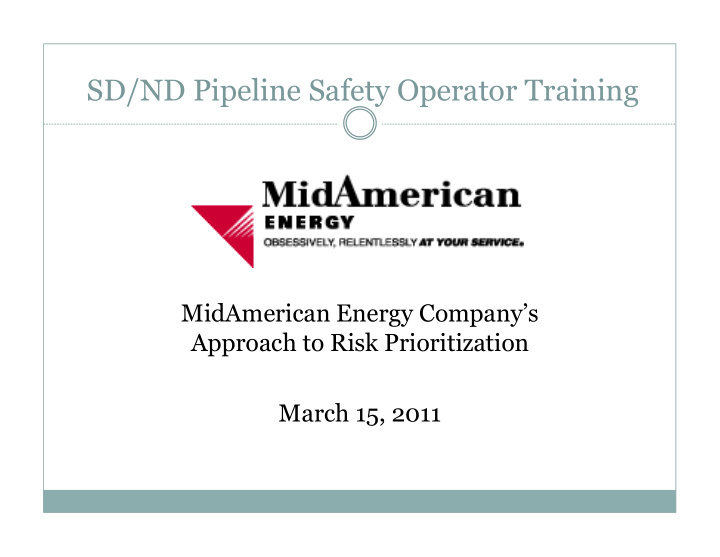



SD/ND Pipeline Safety Operator Training MidAmerican Energy Company’s Approach to Risk Prioritization March 15, 2011
Distribution Integrity Management 2 MEC Background: � Serve natural gas to over 700,000 customers in Illinois, Iowa, Nebraska and South Dakota � Over 12,000 miles of Distribution vs. 800 miles of Transmission � Distribution system is composed of many materials due to age of system and previous company acquisitions/predecessors � Steel – bare, coated, protected and unprotected � Plastic – first and second generations � Cast Iron/Wrought Iron � Copper •March 15, 2011
Distribution Integrity Management 3 Today’s Agenda: � MidAmerican Energy Company (MEC’s) DIMP Update � Risk Prioritization Process � Review of DIMP Pilot Audit w/PHMSA and State Regulators � Questions •March 15, 2011
Distribution Integrity Management 4 Where is MEC at with DIMP? � Written DIMP development � Reviewed by internal Advisory Team 7/15/10 � Reviewed by Structural Integrity Associates 8/31/10 � Pre-audit with PHMSA, ICC, IUB and SDPUC completed Nov. 11-15 at MEC’s Urbandale, IA facility � Plan approved by Management on 12/27/10 •March 15, 2011
Distribution Integrity Management 5 � Risk Model Development � Purchased software model � Model in operation – working on display of web app. mapping and hardware issues (i.e. moving from test to production) � Will use SME’s to validate model and integrate results from the Plastic Pipe Study, 3 rd Party Damage Program, Public Awareness and other sources •March 15, 2011
Distribution Integrity Management 6 � Implementation Plan � On target for 8/2/2011 implementation of DIMP � Written Implementation Plan complete – addresses: � Additional information needs - DOT reporting and data cleanup � Resource needs - software/hardware, voucher (outside services) dollars, and Management approval of company labor hours � Training – CBT training courses developed •March 15, 2011
Distribution Integrity Management 7 MEC’s Approach to Risk Prioritization What is Risk? Risk = Likelihood of Failure * Consequences of Failure What is Failure? Failure = An unintended release of gas that results in an incident (fire or explosion) •March 15, 2011
Distribution Integrity Management 8 Model background � Mains Replacement Prioritization (MRP) developed by GL Noble Denton � Metallic model ONLY – future updates (UPTIME) will include plastic modeling � Model is proprietary and based upon 15 years of actual pipe performance and incident statistics in a distribution system � Model is performance based � Primary purpose is to determine replacement prioritization for Metallic MAINS � Service leak history is not currently used to score the mains •March 15, 2011
Distribution Integrity Management 9 Model Input and Parameters � Model’s input includes: � Facility data (material, size, pressure, etc.) � Gas Leak data � Proximity data � Cover type data � Replacement costs � Modeling parameters include: � Time frame for replacement � Budget information � Replacement strategies (i.e. merging, buffering, etc.) •March 15, 2011
Distribution Integrity Management 10 Model Output � Model’s output includes: � Graphical results – indicates risk scores by pipe segment and resulting replacement “Projects” � Tabular results – can display resulting Project footages, and costs •March 15, 2011
Distribution Integrity Management 11 •March 15, 2011
Distribution Integrity Management 12 •March 15, 2011
Distribution Integrity Management 13 •March 15, 2011
Distribution Integrity Management 14 •March 15, 2011
Distribution Integrity Management 15 What about plastic and other materials? � Material performance is measured from: � Plastic Pipe Study (currently a 3-year cycle) � Gas Leak Data � Material Failure Data � SME knowledge and experience � Material Testing/Studies •March 15, 2011
Distribution Integrity Management 16 How Does it all Come Together? � Current Process: MRP model is assembled and run 1. 2. Distribution statistical summary report is completed 3. Additional performance information is gathered, i.e. CP performance, Plastic Pipe Study, Material Failure trends, etc. 4. The SME’s gather information pertinent to their area, i.e. local construction projects 5. “Risk Review” Meetings are held 6. SME’s and DIMP Manager work together to form both O&M and Capital strategies to reduce risk on the distribution system The resulting projects are approved by Advisory Team, and 7. Management and are budgeted for following years •March 15, 2011
17
Distribution Integrity Management 18 QUESTIONS? •March 15, 2011
Recommend
More recommend